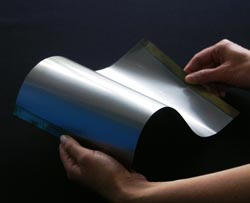Glass-like diffusion barrier for flexible CIGS solar cells for spraying

Barrier layer for flexible CIGS solar cells<br>Source: INM <br>
A wet chemistry spray process can then be used to apply it to flexible and rigid substrates with a variety of shapes.
The INM will be exhibiting these and other developments from 23 to 24 October at Eurofinish 2013 in Ghent (Belgium).
The glass-like layer increases the efficiency of the solar cells in a different way. “It acts as an iron diffusion barrier, preventing corrosion and oxidation of the substrate”, explains Peter William de Oliveira, Head of the Optical Materials Program Division.
“At the same time, the barrier works as an insulating layer and reduces unwanted electrical currents from the absorber to the substrate”, he adds. In addition, the coating is a source for the doping element sodium which increases the efficiency of metal-based CIGS solar cells to 13%. The new barrier layer also makes it possible to monolithically connect several cells on one and the same substrate to modules.
The glass-like diffusion barrier is applied to the metal substrate using the sol-gel process. It is transparent, flexible and only a few micrometers thick. A3 size films can be produced by dip coating and slit coating. For the further upscaling process, researchers at the INM then developed a method with which they can apply the coating via a spray process to large substrates with a variety of shapes. In addition, films up to 50 meters long and just under half a meter wide can also be coated using classic roll-to-roll processes.
Contact:
Dr Peter William de Oliveira
INM – Leibniz Institute for New Materials
Head Program Division Optical Materials
Phone: +49681-9300-148
peter.oliveira@inm-gmbh.de
INM conducts research and development to create new materials – for today, tomorrow and beyond. Chemists, physicists, biologists, materials scientists and engineers team up to focus on these essential questions: Which material properties are new, how can they be investigated and how can they be tailored for industrial applications in the future? Four research thrusts determine the current developments at INM: New materials for energy application, new concepts for implant surfaces, new surfaces for tribological applications and nanosafety/nanobio interaction. Research at INM is performed in three fields: Chemical Nanotechnology, Interface Materials, and Materials in Biology.
INM – Leibniz Institute for New Materials, situated in Saarbruecken, is an internationally leading centre for materials research. It is an institute of the Leibniz Association and has about 190 employees.
Media Contact
More Information:
http://www.inm-gmbh.deAll latest news from the category: Trade Fair News
Newest articles

Parallel Paths: Understanding Malaria Resistance in Chimpanzees and Humans
The closest relatives of humans adapt genetically to habitats and infections Survival of the Fittest: Genetic Adaptations Uncovered in Chimpanzees Görlitz, 10.01.2025. Chimpanzees have genetic adaptations that help them survive…

You are What You Eat—Stanford Study Links Fiber to Anti-Cancer Gene Modulation
The Fiber Gap: A Growing Concern in American Diets Fiber is well known to be an important part of a healthy diet, yet less than 10% of Americans eat the minimum recommended…

Trust Your Gut—RNA-Protein Discovery for Better Immunity
HIRI researchers uncover control mechanisms of polysaccharide utilization in Bacteroides thetaiotaomicron. Researchers at the Helmholtz Institute for RNA-based Infection Research (HIRI) and the Julius-Maximilians-Universität (JMU) in Würzburg have identified a…



